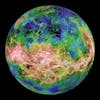Why Venus Rotates So Slowly And In The Wrong Direction
A new study suggests that Venus is gravitationally tidally locked to the sun. And that explains why it's so strange compared to the Earth.
The findings, reported in the Journal Nature Astronomy, may help to address some of the many questions about Earth's sister planet, which need answering.
Venus and Earth are almost exactly the same size and were formed in the same part of the solar system, out of the same materials and under similar conditions. Yet while the Earth is a warm, wet world capable of supporting a vast array of life in all its many wondrous forms, Venus is the nearest thing to hell in our solar system.
It has a surface temperature of over 460 degrees Celsius. It's hot enough to melt lead, and a thick cloud cover crushes down the planet's dense carbon dioxide atmosphere, giving it a surface pressure 100 times greater than that at sea level on Earth.
When it does rain on Venus, it rains sulfuric acid, with metal snow falling on the mountaintops. And finally, the planet rotates backwards, with the sun rising in the west and setting in the east. And so slowly, a Venusian day lasts longer than its year.
Some scientists speculate that were it not for the soupy fast-moving atmosphere on Venus, Earth's sister planet wouldn't rotate at all. Instead, Venus would be tidally locked in place, always facing the sun with the same side in the same way that the same side of the Moon always faces the Earth.
The gravity of a large object in space can stop a smaller object from spinning. It's a phenomenon known as gravitational tidal locking. And if that is what's happening on Venus, scientists argue that the atmosphere needs to be a far more prominent factor in studies of both Venus and other planets.
The study’s lead author Stephen Caine from the University of California, Riverside, says people think of an atmosphere as a thin almost separate layer on top of the planet, something that has minimal interaction with a solid planet beneath. Cain says Venus's powerful atmosphere teaches science that it's far more integrated with the planet and that it affects absolutely everything, even how fast the planet rotates.
Venus takes 243 Earth days to rotate once on its axis, but its atmospheric circles around the planet every four Earth days. Extremely fast winds cause the atmosphere to drag along the surface of the planet as it circulates, slowing its rotation while also loosening the grip of the Sun's gravity. And slow rotation, in turn, has dramatic consequences for the sweltering Venusian climate.
Caine points out Venus is incredibly alien. One reason for the heat is that nearly all the Sun's energy absorbed by the planet is soaked up by the Venusian atmosphere, never reaching the surface. He says this means that a Rover with solar panels like the one NASA sent to Mars simply wouldn't work there.
And the Venusian atmosphere also blocks the Sun's energy from leaving the planet, preventing cooling or the pooling of liquid water on the surface and giving the planet its runaway greenhouse effect.
Cain says it's unclear whether being partially tidally locked contributes to the greenhouse state, a condition which ultimately renders the planet uninhabitable as we know it.
But, he says, not only is it important to gain clarity on this question to understand Venus, it's also important for understanding exoplanets likely to be targeted in future NASA missions.
Most of the planets likely to be observed by the James Webb Space Telescope are very close to their stars, even closer than Venus's to the sun. Therefore, they're also likely to be tidally locked. And since humans may never be able to visit these exoplanets in person, making sure computer models account for the effects of tidal locking is critical.
This is SpaceTime.
























